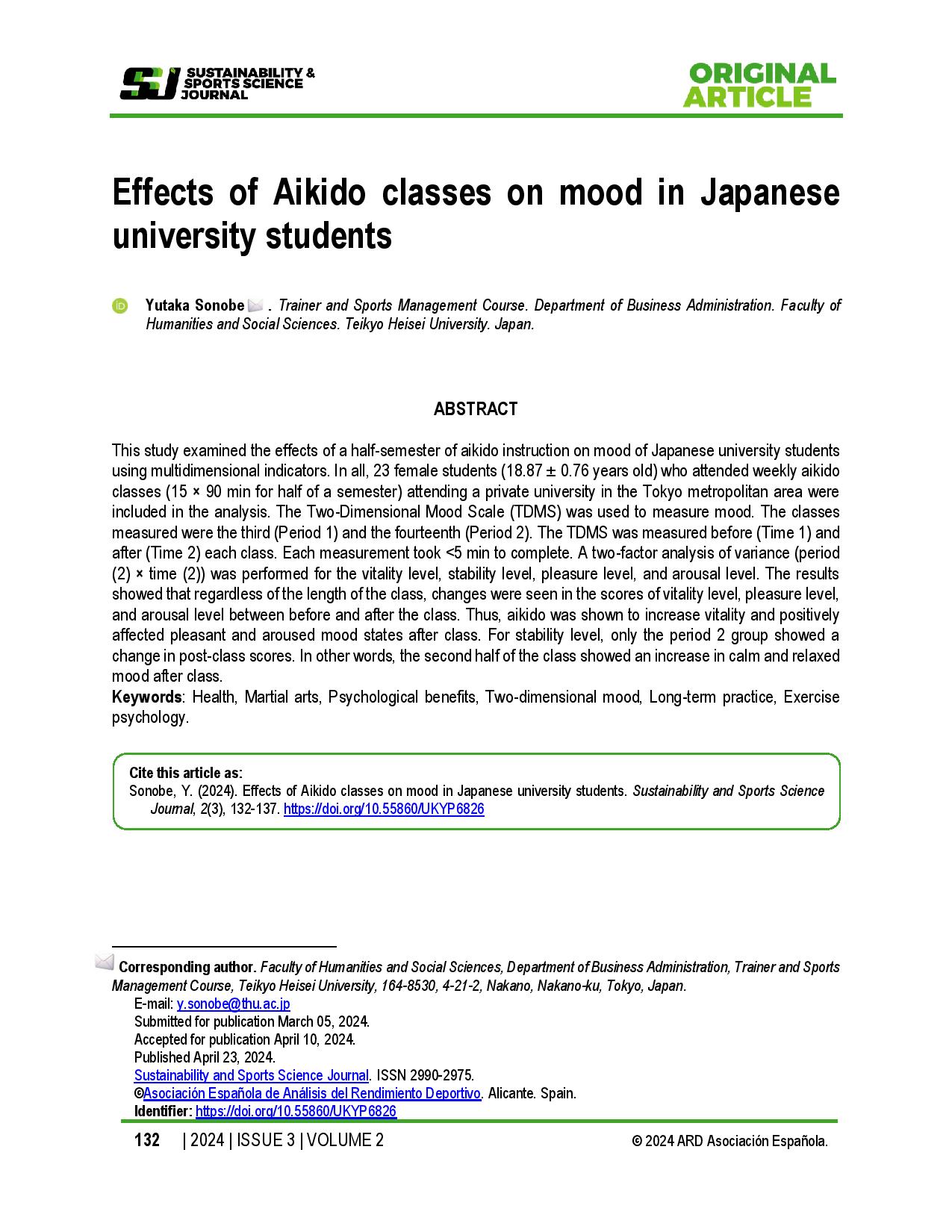Effects of Aikido classes on mood in Japanese university students
Main Article Content
Abstract
This study examined the effects of a half-semester of aikido instruction on mood of Japanese university students using multidimensional indicators. In all, 23 female students (18.87 ± 0.76 years old) who attended weekly aikido classes (15 × 90 min for half of a semester) attending a private university in the Tokyo metropolitan area were included in the analysis. The Two-Dimensional Mood Scale (TDMS) was used to measure mood. The classes measured were the third (Period 1) and the fourteenth (Period 2). The TDMS was measured before (Time 1) and after (Time 2) each class. Each measurement took <5 min to complete. A two-factor analysis of variance (period (2) × time (2)) was performed for the vitality level, stability level, pleasure level, and arousal level. The results showed that regardless of the length of the class, changes were seen in the scores of vitality level, pleasure level, and arousal level between before and after the class. Thus, aikido was shown to increase vitality and positively affected pleasant and aroused mood states after class. For stability level, only the period 2 group showed a change in post-class scores. In other words, the second half of the class showed an increase in calm and relaxed mood after class.
Article Details

This work is licensed under a Creative Commons Attribution-NonCommercial-ShareAlike 4.0 International License.
References
Aikikai Foundation. (online). About Aikido. Retrieved from [Accessed April 17, 2024]: http://www.aikikai.or.jp/eng/aikido/about.html
Benjamini, Y., & Hochberg, Y. (1995). Controlling the false discovery rate: A practical and powerful approach to multiple testing. Journal of the Royal Statistical Society: Series B, 57(1), 289-300. https://doi.org/10.1111/j.2517-6161.1995.tb02031.x DOI: https://doi.org/10.1111/j.2517-6161.1995.tb02031.x
Foster, Y. A. (1997). Brief Aikido Training versus Karate and Golf Training and University Students' Scores on Self-Esteem, Anxiety, and Expression of Anger. Perceptual and Motor Skills, 84(2), 609-610. https://doi.org/10.2466/pms.1997.84.2.609 DOI: https://doi.org/10.2466/pms.1997.84.2.609
Fuller, J. R. (1988). Martial arts and psychological health. British Journal of Medical Psychology, 61(4), 317-328. https://doi.org/10.1111/j.2044-8341.1988.tb02794.x DOI: https://doi.org/10.1111/j.2044-8341.1988.tb02794.x
Harwood-Gross, A., Lambez, B., Feldman, R., Zagoory-Sharon, O., & Rassovsky, Y. (2021). The effect of martial arts training on cognitive and psychological functions in at-risk youths. Frontiers in Pediatrics, 9, 707047. https://doi.org/10.3389/fped.2021.707047 DOI: https://doi.org/10.3389/fped.2021.707047
Lothes, J., Hakan, R., & Kassab, K. (2013). Aikido experience and its relation to mindfulness: A two-part study. Perceptual and Motor Skills, 116(1), 30-39. https://doi.org/10.2466/22.23.PMS.116.1.30-39 DOI: https://doi.org/10.2466/22.23.PMS.116.1.30-39
Nolen-Hoeksema, S., Fredrickson, B. L., Loftus, G. R., & Lutz, C. (2014). Atkinson and Hilgard's introduction to psychology (16th ed). Cengage Learning EMEA.
Nosanchuk, T. A. (1981). The Way of the Warrior: The effects of traditional martial arts training on aggressiveness. The Way of the Warrior. Human Relations, 34(6), 435-444. https://doi.org/10.1177/001872678103400601 DOI: https://doi.org/10.1177/001872678103400601
Nosanchuk, T. A., & MacNeil, M. L. C. (1989). Examination of the effects of traditional and modern martial arts training on aggressiveness. Aggressive Behavior, 15(2), 153-159. https://doi.org/10.1002/1098-2337(1989)15:2<153::AID-AB2480150203>3.0.CO;2-V DOI: https://doi.org/10.1002/1098-2337(1989)15:2<153::AID-AB2480150203>3.0.CO;2-V
Oka, K., Takenaka, K., & Sakata, N. (1994). Iceberg Plofile as a substitution for POMS. Okayama Journal of Physical Education, 1, 21-30.
R Core Team. (2022). R: A Language and Environment for Statistical Computing. https://www.r-project.org/. R Foundation for Statistical Computing.
Rejeski, W. J. (1985). Perceived exertion: An active or passive process? Journal of Sport Psychology, 7(4), 371-378. https://doi.org/10.1123/jsp.7.4.371 DOI: https://doi.org/10.1123/jsp.7.4.371
Sakairi, Y., Nakatsuka, K., & Shimizu, T. (2013). Development of the Two-Dimensional Mood Scale for self-monitoring and self-regulation of momentary mood states. Japanese Psychological Research, 55(4), 338-349. https://doi.org/10.1111/jpr.12021 DOI: https://doi.org/10.1111/jpr.12021
Sonobe, Y. (2013). Effects of one Aikido session on mood states. Research Journal of Budo, 45(3), 173-180. https://doi.org/10.11214/budo.45.173
Sonobe, Y., Uehara, K., Ueguchi, T., & Hajime, M. (2009). Effect of the introduction of aikido into physical education at a university-The case of female students-. Research Journal of Budo, 42(1), 23-29. https://doi.org/10.11214/budo.42.1_23 DOI: https://doi.org/10.1097/00001416-200907000-00013
Szabolcs, Z., Köteles, F., & Szabó, A. (2017). Physiological and psychological benefits of aikido training: A systematic review. Archives of Budo, 13, 271-283.
Vertonghen, J., Theeboom, M., & Pieter, W. (2014). Mediating factors in martial arts and combat sports: An analysis of the type of martial art, characteristics, and social background of young participants. Perceptual and Motor Skills, 118(1), 41-61. https://doi.org/10.2466/06.30.PMS.118k14w3 DOI: https://doi.org/10.2466/06.30.PMS.118k14w3
Weiser, M., Kutz, I., Kutz, S. J., & Weiser, D. (1995). Psychotherapeutic aspects of the martial arts. American Journal of Psychotherapy, 49(1), 118-127. https://doi.org/10.1176/appi.psychotherapy.1995.49.1.118 DOI: https://doi.org/10.1176/appi.psychotherapy.1995.49.1.118




